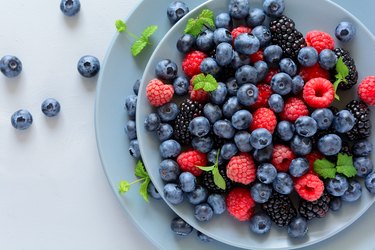
While low-fat or fat-free foods can be part of a healthy diet, simply ditching fat isn't the fast track to weight-loss success, according to the National Library of Medicine (NLM). Fat-free foods may have added sugars, starches and salt to replace the flavoring of the missing fats.
There are 9 calories in every gram of fat, while a gram of protein or carbohydrate contains 4 calories, according to the American Heart Association. That means low-fat foods can provide lower-calorie options. Incorporate fat-free foods — foods that contain less than half a gram of fat per serving — into your diet to help limit your calorie intake.
Video of the Day
Video of the Day
Here are some staples and snacks to add to your low-fat grocery list.
Fruits and Vegetables
Most fruits and vegetables are non-fatty foods in their purest forms. Coconuts and avocados are exceptions.
Fat-free produce includes:
- Berries
- Melon
- Peaches
- Plums
- Apples
- Grapes
- Citrus
- Leafy greens
- Sprouts
- Cucumber
- Celery
- Mushrooms
- Asparagus
- Sweet potato
- Broccoli
Keep in mind adding cheese sauce, butter and other toppings to fat-free produce increases the fat content. Herbs and spices are fat-free ways to add flavor.
Protein
Most beans and legumes are fat-free when they are closest to their natural form. Canned beans often don't have added fats and are ready to eat — be sure to choose a low-sodium variety.
- Beans
- Lentils
- Peas
- Egg whites
Dairy
Dairy products can be made fat-free and still deliver similar levels of protein. Look for:
- Fat-free milk
- Nonfat yogurt
- Fat-free cottage cheese
Condiments
While creamy sauces typically are high in fat, there are many fat-free condiments you can use to flavor food.
- Soy sauce
- Worcestershire sauce
- Mustard
- Ketchup
- Vinegar
- Salsa
Don't forget to practice portion control when using condiments to flavor your meals. While they might be free of fat, many condiments are high in sugar or sodium.
Grains
Many grains are naturally fat-free but some fat is added during processing. Read nutrition labels carefully and you may be able to find some fat-free cereals or whole-grain breads, bagels and pastas.
Pros and Cons of Fat-Free Foods
Choosing fat-free foods can help you keep your total calorie intake in check and may help with high cholesterol.
But fat-free foods aren't automatically healthy. Many candies, although fat-free, are not healthy additions to your diet, for example. Enjoy fat-free foods in addition to an overall nourishing diet to help cut calories and aid in a healthy lifestyle.
Your body needs some fat to function, per the NLM. It's good for your hair and skin, helps you absorb vitamins and provides essential fatty acids.
Just choose healthy unsaturated fats, like those in avocado, nuts and fatty fish like salmon, rather than saturated fats, like those found in butter and red meat.
FAQ
Common Questions
What cheeses are the lowest in fat?
Cheese naturally contains saturated fat, but some cheeses are lower in fat or can be made in reduced-fat varieties. Choose from low-fat cheeses like ricotta, feta and provolone.
Is a no-fat diet good for you?
You need some fat to survive and thrive. Without it, you could have problems with your hair and skin and become deficient in certain essential nutrients. Your energy levels could falter, and you could actually gain weight. A low-fat diet is a healthier option than a no-fat diet. Just make sure to eat foods high in healthy unsaturated fats.
Can you eat eggs on a low-fat diet?
Absolutely. One egg has just 5 grams of fat, and about 3 of those are the healthy unsaturated type, according to the USDA. Preparation matters, though: If you're cooking your eggs with butter or milk, you'll be adding more fat to your dish.
Was this article helpful?
150 Characters Max
0/150
Thank you for sharing!
Thank you for your feedback!